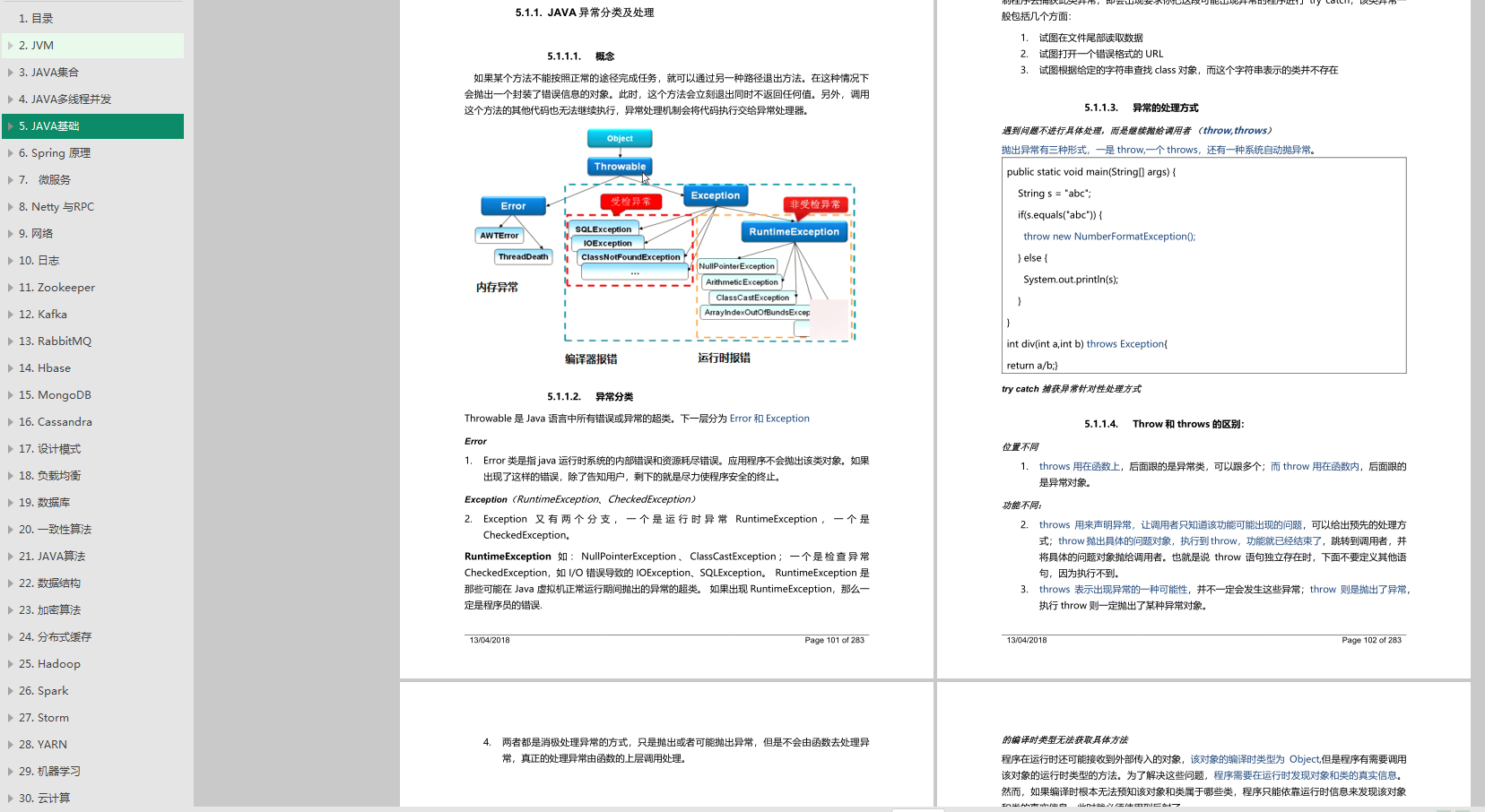20 道题帮你一举拿下二叉树算法题(附源代码)

第一题:求二叉树中的节点个数
第二题:求二叉树的最大层数(最大深度)
第三题:先序遍历/前序遍历
第四题:中序遍历
第五题:后序遍历
第六题:分层遍历
第七题:求二叉树第K层的节点个数
第八题:求二叉树第K层的叶子节点个数
第九题:判断两棵二叉树是否结构相同
第十题:判断二叉树是不是平衡二叉树
第十一题: 求二叉树的镜像
第十二题:求二叉树中两个节点的最低公共祖先节点
第十三题:求二叉树的直径
第十四题:由前序遍历序列和中序遍历序列重建二叉树
第十五题: 判断二叉树是不是完全二叉树
第十六题:树的子结构
第十七题:二叉树中和为某一值的路径
第十八题:二叉树的下一个结点
第十九题:序列化二叉树
第二十题:二叉搜索树的第k个结点
第一题:求二叉树中的节点个数
递归解法:
(1)如果二叉树为空,节点个数为0
(2)如果不为空,二叉树节点个数 = 左子树节点个数 + 右子树节点个数 + 1
参考代码如下:
public static int getNodeNumRec(TreeNode root) {
if (root == null) {
return 0;
}
return getNodeNumRec(root.left) + getNodeNumRec(root.right) + 1;
}
第二题:二叉树的最大层数(最大深度)
递归解法 :
(1)如果二叉树为空,二叉树的深度为0
(2)如果二叉树不为空,二叉树的深度 = max(左子树深度, 右子树深度) + 1
参考代码如下:
/**
* Definition for a binary tree node.
* public class TreeNode {
* int val;
* TreeNode left;
* TreeNode right;
* TreeNode(int x) { val = x; }
* }
*/
class Solution {
public int maxDepth(TreeNode root) {
if(root == null)
return 0;
return Math.max(maxDepth(root.left), maxDepth(root.right))+1;
}
}
2.1 二叉树的最小深度
LeetCode:Minimum Depth of Binary Tree 给定一个二叉树,找出其最小深度。 最小深度是从根节点到最近叶子节点的最短路径上的节点数量。
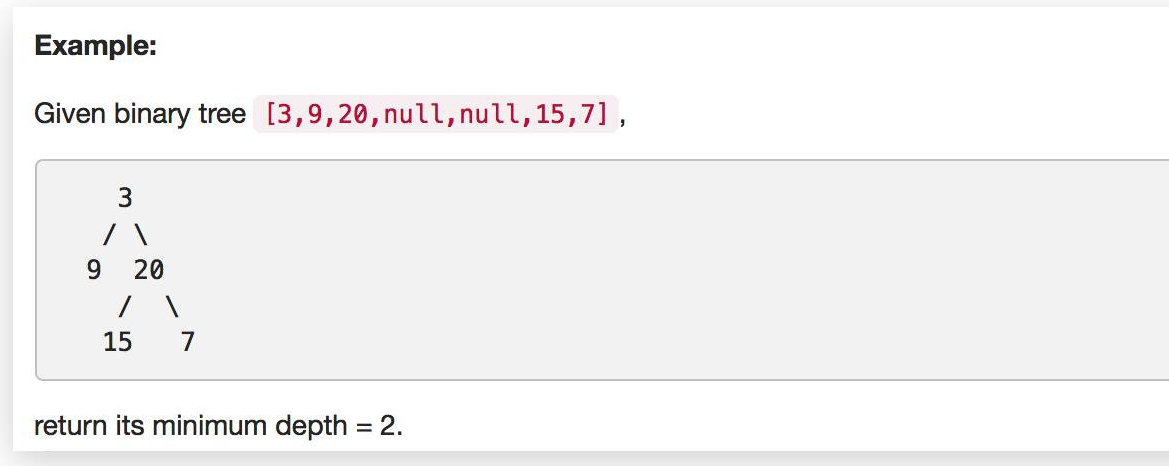
lass Solution {
public int minDepth(TreeNode root) {
if(root == null)
return 0;
int left = minDepth(root.left);
int right = minDepth(root.right);
return (left == 0 || right == 0) ? left + right + 1 : Math.min(left, right) + 1;
}
}
第三题:先序遍历/前序遍历
LeetCode:Binary Tree Preorder Traversal 给定二叉树,返回其节点值的前序遍历。
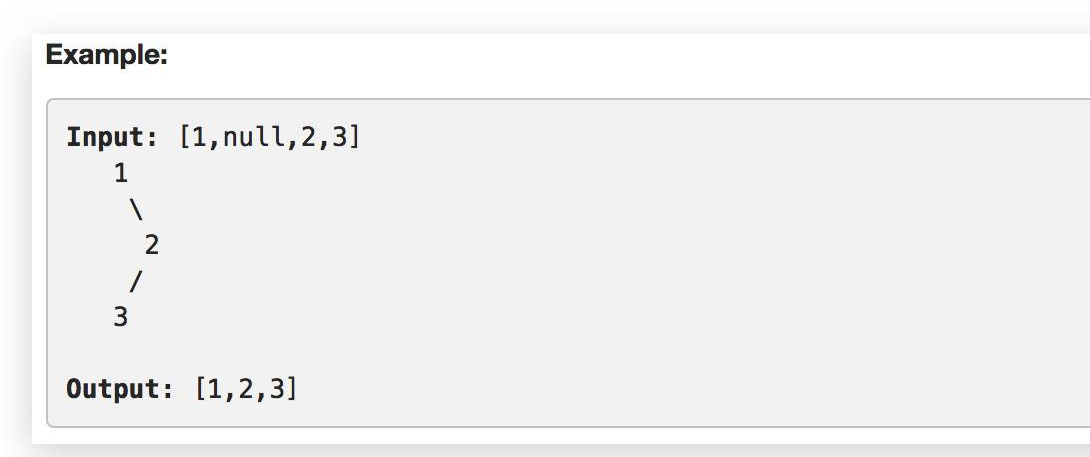
根 - 左 - 右递归
ArrayList<Integer> preOrderReverse(TreeNode root){
ArrayList<Integer> result = new ArrayList<Integer>();
preOrder(root, result);
return result;
}
void preOrder(TreeNode root,ArrayList<Integer> result){
if(root == null){
return;
}
result.add(root.val);
preOrder(root.left, result);
preOrder(root.right, result);
}
非递归
法一:
import java.util.Stack;
class Solution {
public List<Integer> preorderTraversal(TreeNode root) {
LinkedList<Integer> res = new LinkedList<>();
if(root == null)
return res;
Stack<TreeNode> stack = new Stack<>();
stack.push(root);
while(!stack.isEmpty()){
TreeNode node = stack.pop();
res.add(node.val);
if(node.right != null){
stack.push(node.right);
}
if(node.left != null){
stack.push(node.left);
}
}
return res;
}
}
法二:
class Solution {
public List<Integer> preorderTraversal(TreeNode root) {
List<Integer> res = new ArrayList<Integer>();
if(root == null)
return res;
Stack<TreeNode> stack = new Stack<TreeNode>();
TreeNode cur = root;
while(cur != null || !stack.isEmpty()){
if(cur!=null){
res.add(cur.val);
stack.push(cur);
cur = cur.left;
}else{
cur = stack.pop();
cur = cur.right;
}
}
return res;
}
}
第四题:中序遍历
LeetCode:Binary Tree Inorder Traversal 给定二叉树,返回其节点值的中序遍历。
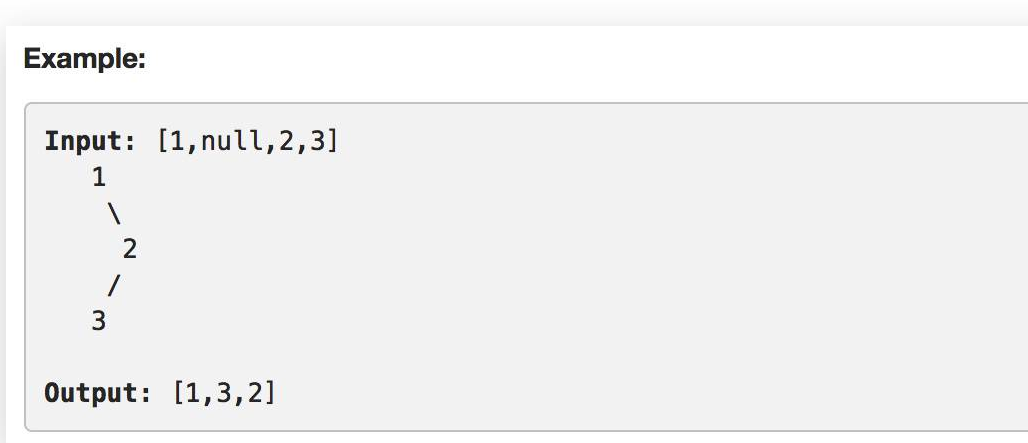
左 - 根 - 右递归
void inOrder(TreeNode root,ArrayList<Integer> result){
if(root == null){
return;
}
preOrder(root.left, result);
result.add(root.val);
preOrder(root.right, result);
}
非递归
/**
* Definition for a binary tree node.
* public class TreeNode {
* int val;
* TreeNode left;
* TreeNode right;
* TreeNode(int x) { val = x; }
* }
*/
class Solution {
public List<Integer> inorderTraversal(TreeNode root) {
List<Integer> res = new ArrayList<Integer>();
if(root == null)
return res;
Stack<TreeNode> stack = new Stack<TreeNode>();
TreeNode cur = root;
while(!stack.isEmpty() || cur != null){
if(cur != null){
stack.push(cur);
cur = cur.left;
}else{
cur = stack.pop();
res.add(cur.val);
cur = cur.right;
}
}
return res;
}
}
第五题:后序遍历
Leetcode:Binary Tree Postorder Traversal 给定二叉树,返回其节点值的后序遍历。
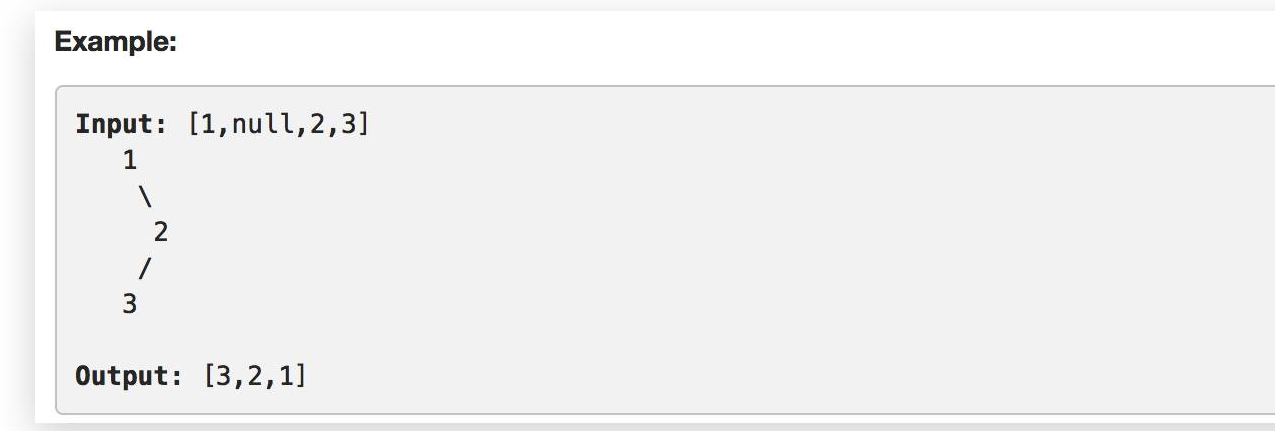
左 - 右 - 根递归
void inOrder(TreeNode root,ArrayList<Integer> result){
if(root == null){
return;
}
preOrder(root.left, result);
preOrder(root.right, result);
result.add(root.val);
}
非递归
方法一:
/**
* Definition for a binary tree node.
* public class TreeNode {
* int val;
* TreeNode left;
* TreeNode right;
* TreeNode(int x) { val = x; }
* }
*/
class Solution {
public List<Integer> postorderTraversal(TreeNode root) {
LinkedList<Integer> ans = new LinkedList<>();
Stack<TreeNode> stack = new Stack<>();
if (root == null) return ans;
stack.push(root);
while (!stack.isEmpty()) {
TreeNode cur = stack.pop();
//采用逆序插入的方式
ans.addFirst(cur.val);
if (cur.left != null) {
stack.push(cur.left);
}
if (cur.right != null) {
stack.push(cur.right);
}
}
return ans;
}
}
方法二:
/**
* Definition for a binary tree node.
* public class TreeNode {
* int val;
* TreeNode left;
* TreeNode right;
* TreeNode(int x) { val = x; }
* }
*/
class Solution {
public List<Integer> postorderTraversal(TreeNode root) {
List<Integer> res = new ArrayList<Integer>();
if(root == null)
return res;
Stack<TreeNode> stack = new Stack<TreeNode>();
TreeNode cur = root;
TreeNode visited = null;
while(!stack.isEmpty() || cur != null){
if(cur != null){
stack.push(cur);
cur = cur.left;
}else{
cur = stack.peek();
if(cur.right != null && cur.right != visited){
cur = cur.right;
}else{
res.add(cur.val);
visited = cur;
stack.pop();
cur = null;
}
}
}
return res;
}
}
方法三(推荐):
class Solution {
public List<Integer> postorderTraversal(TreeNode root) {
LinkedList<Integer> result = new LinkedList<>();
Deque<TreeNode> stack = new ArrayDeque<>();
TreeNode p = root;
while(!stack.isEmpty() || p != null) {
if(p != null) {
stack.push(p);
result.addFirst(p.val); // Reverse the process of preorder
p = p.right; // Reverse the process of preorder
} else {
TreeNode node = stack.pop();
p = node.left; // Reverse the process of preorder
}
}
return result;
}
}
由于篇幅原因,剩下的15道二叉树算法题(附代码)这里就不一一罗列出来了,小编已将这20道二叉树算法题(附代码)全部整理成Word文档了。
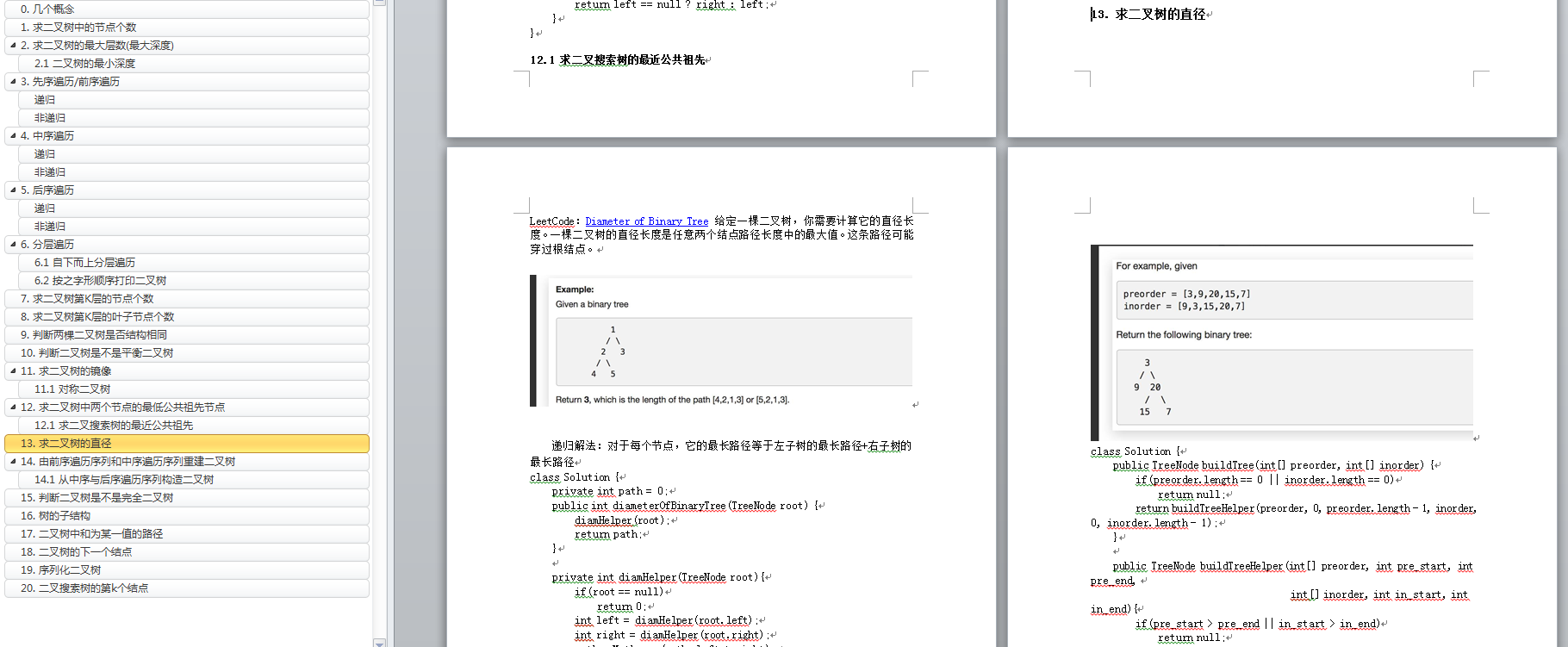
再分享一波我的算法复习资料(PDF):编程技巧,线性表,字符串,栈和队列,树,排序,查找,暴力枚举法,广度优先搜索,深度优先搜索,分治法,贪心法,动态规划

以及JAVA核心知识点整理(PDF):包含JVM,JAVA集合,JAVA多线程并发,Spring原理,微服务,Netty与RPC,网络,Zookeeper,Kafka,RabbitMQ,MongoDB,设计模式,负载均衡,数据库,一致性哈希,JAVA算法,数据结构,分布式缓存等等
